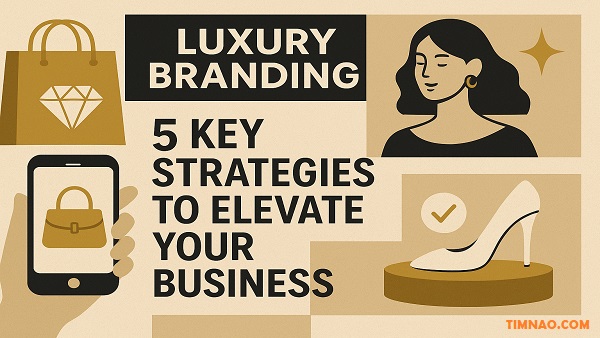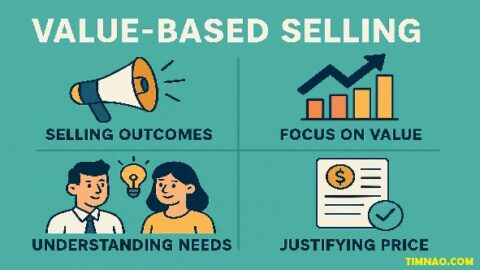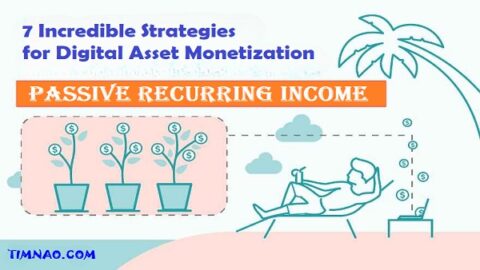🌟 Unlocking the Secrets of Luxury Marketing: Proven Strategies Beginners Can Learn From
Luxury marketing isn’t just about selling expensive products—it’s about creating desire, emotion, and unforgettable experiences. Behind every iconic brand, from Chanel to Ferrari, lies a carefully crafted strategy that turns ordinary goods into symbols of status, aspiration, and lifestyle.
In today’s world, the rules of luxury marketing have started to reshape how all businesses—big or small—can connect with their audiences. Whether it’s through storytelling, personalized experiences, or even cutting-edge digital tools like AI and NFTs, luxury brands are setting standards that every beginner in marketing can learn from.
This article will guide you through the essential principles of luxury brand strategy in a way that’s clear, accessible, and filled with real-world examples. Even if you’re just starting out, you’ll discover practical insights you can use to elevate your own projects, products, or services. Think of it as unlocking the “secret playbook” that makes luxury brands unforgettable—and learning how to apply those lessons to your own journey.
Table of Contents
- 💎 Why Luxury Marketing Matters More Than Ever
- 🧠 The Psychology Behind Luxury Purchases
- 💰 The Power of Pricing and Perceived Value
- 🌍 Building Global Appeal While Keeping Local Roots
- 🛍️ Crafting Memorable Customer Experiences
- 🌱 Luxury Meets Sustainability: A New Standard
- 📱 Digital Transformation in the Luxury Industry
- 🚪 Distribution Channels: From Flagship Stores to Online Exclusives
- 🚀 Innovation and Future Trends in Luxury Branding
- 📝 Key Lessons Beginners Can Apply Today
💎 Why Luxury Marketing Matters More Than Ever
Luxury may sound like something reserved for billion-dollar brands with glossy flagship stores. But the principles behind luxury marketing are surprisingly useful—even for small businesses, freelancers, or anyone trying to build a strong personal brand. The truth is, luxury brands excel at one thing most beginners overlook: they sell emotions, not just products.
In today’s competitive world, standing out often has little to do with lowering prices or adding more features. Customers remember the way you make them feel. That’s why luxury marketing matters more than ever—it offers timeless lessons on building loyalty, creating desire, and turning an ordinary product into something extraordinary.
What Beginners Can Learn From Luxury Brands
You might think, “I don’t sell handbags or jewelry, so what does this have to do with me?” The answer: everything. The same strategies that make Chanel or Rolex irresistible can be scaled down and applied to your Etsy shop, online course, or consulting service.
For example:
- A small candle business can present its products in elegant, eco-friendly boxes tied with a ribbon, instantly feeling more premium than a bare jar.
- A freelance designer can limit client slots each month, creating scarcity that increases demand.
- An online coach can add personalized welcome messages for new members, creating a VIP experience.
Luxury marketing teaches us to shift focus from the object itself to the perception around it. For beginners, that means your story, your presentation, and the emotions you trigger can often matter more than the raw features of your product.
💡 Quick Action for Beginners:
- Take one product or service you already sell. Ask yourself: How could I present this as if it were a luxury brand? Could you improve packaging, write a stronger brand story, or create a limited edition? Pick one idea and test it this week.
🧠 The Psychology Behind Luxury Purchases
Why do people spend thousands on a bag when a cheaper one carries items just as well? The answer lies in psychology. Luxury products often fulfill deeper emotional needs like belonging, status, identity, and even reward.
Status and Recognition
Luxury often signals achievement. When someone buys a Rolex, it’s not about keeping time—it’s about broadcasting success. Beginners can apply this by thinking: What status does my product or service give my customer? Even small brands can offer a sense of pride. A handmade notebook, for example, can be marketed as “for thinkers and creators who value originality.” Suddenly, it’s not just paper—it’s identity.
💡 Try This: Write down one sentence that describes how your product or service elevates your customer’s sense of self. Example: “This coffee subscription isn’t just about caffeine—it’s for people who value slow mornings and rituals.”
Scarcity and Exclusivity
Luxury thrives on scarcity. When people know something is limited, it feels more valuable. Think about sneaker drops, concert tickets, or even seasonal menus at a café—these all borrow from luxury psychology.
As a beginner, you can use scarcity without being manipulative:
- Offer a limited number of slots, editions, or bundles.
- Set deadlines for special offers.
- Release seasonal or holiday editions of your product.
This doesn’t require expensive campaigns—just a shift in framing. A candle business could release “Only 50 Valentine’s Day Sets Available.” An online tutor could limit lessons to 10 students per month. Suddenly, demand rises because access feels special.
💡 Quick Win: Create a “limited” option for one of your offers this month—either by number of spots or by deadline. Promote it clearly as exclusive.
Emotional Reward and Self-Treating
Another driver of luxury purchases is the emotional reward. People often justify expensive purchases as a treat: “I worked hard, I deserve this.” Beginners can tap into this psychology by positioning products as celebrations, not just transactions.
Example:
- A bakery can frame a premium cake as “a celebration you deserve after a tough week.”
- A digital service can present itself as “an investment in your peace of mind.”
This type of framing gives buyers emotional permission to spend.
💡 Action Step: Look at your sales copy or product descriptions. Add a line that connects your offer to a reward or positive emotional state, like: “A reminder that you’ve earned something special.”
Personal Identity and Belonging
Luxury purchases also signal belonging to a community. Driving a Tesla, wearing Supreme, or carrying a Louis Vuitton bag all say something about who you are and who you identify with.
For beginners, community building is a powerful tool. Even without luxury branding, you can make customers feel like part of something bigger. A small skincare brand could create a private Facebook group for customers to share routines. A freelance coach could name their program members as part of an “inner circle.”
💡 Try This: Think of one way to create a sense of community for your customers—maybe a private group, a loyalty club, or even just a shared hashtag they can use.
The Big Takeaway So Far
Luxury marketing isn’t about selling overpriced goods—it’s about tapping into universal human desires. People crave recognition, exclusivity, reward, and belonging. Beginners can absolutely use these levers to elevate even the simplest product or service.
The next time you look at your offer, don’t just ask, “What does this do?” Ask, “How does this make my customer feel?” The answer will shape everything—from your pricing to your packaging.
💰 The Power of Pricing and Perceived Value
Luxury brands know something that beginners often overlook: price is not just a number—it’s a signal. A higher price can actually create higher demand because it communicates quality, exclusivity, and status.
Why High Prices Can Attract Customers
Think about it: if you saw a “luxury” perfume priced at $10, you’d probably doubt its quality. But if that same bottle was priced at $200 and displayed in a sleek boutique, suddenly it feels believable. This is the psychology of perceived value—people assume that higher prices equal higher worth.
As a beginner, the lesson is this: don’t underprice yourself out of fear. If you price too low, you might make sales, but you won’t create lasting brand value. Customers may see your offer as cheap rather than premium.
💡 Quick Action: Review your current pricing. Ask yourself: Does this number reflect the quality and story I want my brand to tell? If not, consider testing a premium version of your product at a higher price.
Anchoring: The “Premium” Trick
Luxury brands often use pricing anchors to shape perception. They may present three options: a standard, a premium, and a deluxe. Most customers choose the middle one, but the presence of the deluxe option makes the middle price feel more reasonable.
Beginners can use this too. For example:
- A photographer could offer three packages: Basic ($500), Premium ($1,200), and Elite ($3,000). Even if few people buy the Elite, it makes Premium feel like a smart choice.
- A digital course creator could offer a self-paced version, a group coaching version, and a VIP version.
This technique allows you to raise perceived value without changing your core product.
💡 Try This: Create a three-tier pricing model for your offer. Make sure the middle option is the one you want most customers to choose.
Scarcity Pricing and Limited Editions
Luxury often justifies higher prices by making products scarce. Think of limited sneaker drops that sell out in minutes. Scarcity doesn’t just create urgency—it also supports higher price tags.
Beginners can use this even with small-scale products or services:
- Release a “special edition” version of your product (limited colors, packaging, or bonus content).
- Offer early-bird pricing to the first 10 customers only.
- Run limited-time offers where scarcity supports higher value.
💡 Quick Win: Pick one product and release a “limited edition” version this month. It could be as simple as a different design, package, or added bonus.
The Danger of Discounts
One mistake beginners make is relying too heavily on discounts. Luxury brands rarely discount, because it erodes perceived value. If a $1,000 bag goes on sale for $500, it tells buyers that maybe it was never worth $1,000 in the first place.
As a beginner, it’s okay to offer promotions—but avoid training your customers to wait for sales. Instead, frame offers as bonuses (e.g., “exclusive gift with purchase”) rather than slashing prices.
💡 Action Step: Audit your promotions. Are you discounting too often? If yes, replace some discounts with “value adds” like free gifts, extended access, or bonus services.
Key Pricing Lessons for Beginners
- Price communicates value—don’t race to the bottom.
- Use anchoring to make your pricing feel balanced.
- Introduce scarcity to support higher demand.
- Avoid discount traps; add value instead.
By mastering these techniques, you don’t just sell—you elevate how people perceive your brand.
🌍 Building Global Appeal While Keeping Local Roots
Luxury brands walk a delicate balance. They are global powerhouses, yet they stay rooted in local traditions. Chanel is unmistakably French, Gucci proudly Italian, and Rolex carries Swiss precision. Their strength lies in blending local authenticity with worldwide appeal.
Why Local Identity Matters
People crave authenticity. A French fragrance feels different because it carries a heritage of French craftsmanship. A Japanese kimono brand holds meaning because of cultural tradition. Local identity is what makes a brand unique in a global sea of sameness.
Beginners can do this too. Even if you’re a small shop, highlight your roots:
- If you bake from a family recipe, tell that story.
- If your products are handmade in a specific town, showcase that origin.
- If your service is inspired by your culture, lean into it proudly.
💡 Quick Action: Write a one-line brand statement that highlights your local roots. Example: “Handcrafted candles inspired by the coastal traditions of Maine.”
Going Global Without Losing Yourself
Luxury brands expand globally by adapting without erasing their DNA. McDonald’s adjusts menus for each country, but Gucci keeps its Italian spirit no matter where it sells. Beginners can learn from this: adapt your marketing for different audiences while staying true to your brand story.
Example:
- A skincare brand rooted in Korean ingredients can still market globally by explaining traditions in ways that resonate internationally.
- A local craft brand could sell on Etsy worldwide but emphasize the uniqueness of their origin story.
💡 Try This: If you sell online, add a “Made in ___” or “Inspired by ___ traditions” section to your product descriptions. It helps you stand out in the global market.
Blending Digital Reach With Local Pride
The internet makes it possible for a small business to reach customers across the globe. But the ones that succeed are those who bring their local essence online. Think of local coffee shops sharing their roasting process on Instagram, or handmade jewelry sellers creating TikTok videos about the tradition behind their craft.
This mix of global accessibility and local pride creates a brand that feels both authentic and aspirational.
💡 Quick Win: Create one piece of content this week that shows your “local roots”—a behind-the-scenes video, a story about your process, or a highlight of where your materials come from.
Lessons Beginners Can Apply
- Authenticity builds trust—highlight your local origins.
- Adapt messaging globally but stay true to your brand DNA.
- Use digital platforms to share your story worldwide.
Blending global vision with local identity doesn’t require millions in advertising—it starts with being proud of your roots and sharing that story with the world.
Pulling It Together
Pricing shapes how people value your work, and roots shape how people connect with your story. Luxury brands use these tools to build loyalty and desire, but beginners can use them just as powerfully on a smaller scale.
Your prices tell the world how valuable your brand is. Your story tells the world why you’re worth remembering. Put them together, and you create a brand that feels bigger than the product itself.
🛍️ Crafting Memorable Customer Experiences
Luxury brands know that customers aren’t just buying a product—they’re buying a moment. Walking into an Apple Store feels different from entering a random electronics shop. Visiting a Louis Vuitton boutique feels like stepping into a world of elegance. This isn’t accidental—it’s strategy. The customer experience is as important as the product itself.
Why Experience Matters More Than Features
A handbag may be made of leather, but dozens of non-luxury bags are too. What sets luxury apart is how it feels to buy it: the attention, the packaging, the service, the story. People remember how you made them feel more than what you sold them.
For beginners, this is powerful because you don’t need a massive store to create experiences—you can build small, memorable touches into your business today.
💡 Quick Action: Ask yourself: What’s the emotional journey my customer goes through when buying from me? Map out every step, from the first ad they see to the unboxing moment. Look for one step you can make more delightful.
Personalization That Stands Out
Luxury thrives on making customers feel like individuals, not numbers. High-end hotels often remember your name, preferences, or even your favorite drink. This creates loyalty because customers feel seen.
Beginners can apply this on a smaller scale:
- Include a handwritten thank-you note in every order.
- Send personalized follow-up emails (e.g., “We hope you’re loving your new planner, Sarah!”).
- Offer returning customers a loyalty perk, like early access to a new launch.
These details are inexpensive, but they can make your brand feel premium.
💡 Try This: Choose one customer this week and send them a personal note or small surprise. See how it impacts their response.
The Unboxing Effect
Why do people film “unboxing videos” on YouTube? Because packaging has become part of the experience. Luxury brands use elegant boxes, ribbons, and attention to detail so that opening a product feels like a ritual.
As a beginner, you can achieve this without big budgets:
- Use branded tissue paper, a custom sticker, or eco-friendly wrapping.
- Add a small gift, like a sample or discount code for their next purchase.
- Include a short story card explaining the inspiration behind your product.
💡 Quick Win: Upgrade your packaging slightly—maybe swap generic plastic for kraft paper and a branded sticker. Test it on your next 10 orders.
Online Experiences Matter Too
Customer experience isn’t just physical—it extends online. A confusing checkout page or a generic thank-you email can ruin the vibe. Luxury brands invest in smooth, polished digital journeys, and so can you.
For example:
- Simplify your website’s checkout—fewer clicks means fewer abandoned carts.
- Use friendly, branded thank-you emails instead of generic confirmations.
- Respond quickly and warmly to inquiries—it costs nothing but feels like VIP treatment.
💡 Action Step: Pretend you’re a new customer. Visit your own website or buying flow and write down every step that feels boring, confusing, or “cold.” Fix one of them this week.
Creating Memories, Not Just Transactions
At the end of the day, luxury customer experiences are memorable because they connect with people emotionally. You don’t need marble floors—you just need to care about the journey.
If you can make customers feel excited when they order, delighted when they receive, and valued after they buy, you’ve already mastered the heart of luxury.
🌱 Luxury Meets Sustainability: A New Standard
Luxury is no longer just about gold, diamonds, and indulgence. Modern consumers—especially younger generations—expect brands to be responsible. A luxury item that harms the planet or exploits workers quickly loses its shine. Today, sustainability is part of luxury.
Why Sustainability Adds Value
Luxury customers pay for craftsmanship and longevity. That mindset aligns naturally with sustainability—products that last longer and cause less harm are seen as more premium.
For beginners, this is good news. You don’t need a giant factory to be “green.” Even small steps toward sustainability can make your brand more appealing.
💡 Quick Action: Pick one sustainable change you can make this month—switching to recyclable packaging, sourcing eco-friendly materials, or offering digital receipts instead of paper.
Transparency Builds Trust
Many brands fall into the trap of “greenwashing”—claiming to be eco-friendly without real proof. Modern consumers are quick to call this out. Luxury brands avoid this by being transparent about their efforts. For example, Stella McCartney openly discusses materials and supply chains.
As a beginner, you can do the same on a smaller scale:
- Share where your materials come from.
- Talk about why you chose eco-friendly packaging.
- Be honest about what you’re working to improve.
💡 Try This: Add a “Sustainability Promise” section to your website, even if it’s just one or two clear actions you’re committed to.
Aligning With Customer Values
Consumers today want purchases that reflect their values. Someone who buys an eco-friendly notebook isn’t just buying paper—they’re expressing their identity as someone who cares for the planet.
Beginners can frame sustainability as part of the story:
- “Our candles are hand-poured in small batches using soy wax—better for you and the environment.”
- “Our packaging is 100% recyclable, because beauty shouldn’t come at the planet’s expense.”
This transforms sustainability from a cost into a selling point.
💡 Action Step: Rewrite one of your product descriptions to highlight a sustainable aspect, even if it’s small.
Balancing Luxury and Responsibility
The future of luxury isn’t about choosing between premium and sustainable—it’s about blending the two. A luxury bag made from eco-leather, a watch powered by solar technology, or packaging designed for reuse all show how luxury and responsibility go hand in hand.
For beginners, this is inspiring because it shows you don’t need to sacrifice aspiration to be ethical. In fact, your ethics can become your brand advantage.
💡 Quick Win: Think of one way your brand could combine luxury and responsibility. It might be as simple as offering a reusable bag with purchases or designing products that last longer than the average competitor’s.
Lessons Beginners Can Apply
- Memorable experiences build loyalty—focus on small, personal touches.
- Packaging and personalization elevate even simple products.
- Sustainability is no longer optional—it’s part of what makes something feel premium.
- Transparency about your efforts builds trust and sets you apart.
Pulling It Together
Customer experience and sustainability may seem like “luxury-only” concerns, but they’re actually essential for any brand that wants to stand out. By caring about how people feel and how your business impacts the world, you’re not just selling a product—you’re creating a story customers are proud to be part of.
And when customers feel proud, they don’t just buy once—they return, share, and become your best ambassadors.
📱 Digital Transformation in the Luxury Industry
Luxury has always been about exclusivity, but in today’s world, exclusivity must coexist with accessibility. That’s where digital transformation comes in. From online shopping to virtual fashion shows, luxury brands are embracing technology to stay relevant. And here’s the best part: even small businesses and beginners can learn from these strategies.
The Rise of Online Luxury
Not long ago, luxury brands resisted selling online because they thought digital would cheapen their image. Today, however, e-commerce is one of the strongest growth drivers for luxury. Customers expect convenience without losing the premium feel.
As a beginner, the lesson is clear: online doesn’t have to mean ordinary. You can sell digitally while still making the experience polished and exclusive.
💡 Quick Action: Review your online presence. Does your website or social media feel premium? Even small tweaks—like using consistent brand colors, clean product photos, and storytelling captions—can create a luxury vibe.
Social Media as a Luxury Stage
Luxury brands use Instagram, TikTok, and YouTube not just to advertise, but to create digital experiences. Think about Gucci’s AR filters on Instagram or Louis Vuitton’s fashion show livestreams.
Beginners can use the same mindset:
- Share behind-the-scenes stories to make your brand feel authentic yet aspirational.
- Use video to highlight details that photos can’t capture.
- Create “drops” or teasers on social media to build anticipation.
💡 Try This: Post one teaser this week about an upcoming product, instead of simply announcing it. Build suspense the way luxury brands do.
The Power of Digital Storytelling
Luxury brands tell stories that connect emotionally. Burberry, for example, launched digital campaigns showcasing British heritage through video and music.
Beginners can tell stories online without big budgets:
- Share the inspiration behind a product design.
- Post about the process—handmade details, sourcing, or testing.
- Highlight customer stories using your product or service.
💡 Quick Win: Write one Instagram or LinkedIn post that focuses on why you created your product, not just what it is.
Virtual Try-Ons and Immersive Tech
Luxury brands are experimenting with AR (augmented reality) and VR (virtual reality). Customers can try on sunglasses through apps or attend fashion shows in the metaverse. While beginners don’t need cutting-edge tech, they can use simple tools to enhance experience.
For example:
- Use Canva mockups to show products in real-life settings.
- Offer digital previews of designs before production.
- Create short product demo videos to simulate the “try-on” effect.
💡 Action Step: Record a simple product demo video this week, showing your product in action. Share it on your website or socials.
Why This Matters for Beginners
Digital transformation levels the playing field. With a smartphone and creativity, you can compete in ways that used to require massive budgets. What matters most is not the tool, but the story you tell and how consistently you deliver it.
🚪 Distribution Channels: From Flagship Stores to Online Exclusives
Luxury brands carefully control where and how their products are sold. The right distribution channel makes a product feel special; the wrong one makes it feel cheap. Beginners may not have flagship stores, but they can still control distribution to shape perception.
Flagship Stores and What They Teach Us
Luxury flagships—like Louis Vuitton in Paris or Apple’s Fifth Avenue store—are more than shops. They’re brand temples, designed to immerse customers in the world of the brand.
Beginners can’t build a flagship store, but they can create flagship experiences online or locally.
- Your website can be your “flagship”—clean, intentional, and immersive.
- A local pop-up shop can serve as your “brand temple,” even for a weekend.
- A carefully designed packaging set can act as a “mini-flagship” experience at home.
💡 Quick Action: Audit your website or main sales channel. Ask: Does this feel like a premium place to buy, or just a checkout page? Upgrade one element to feel more immersive.
Selective Distribution Creates Desire
Luxury brands don’t sell everywhere. You won’t find Hermès at a discount outlet. Instead, they sell in selected places that reinforce their value. Beginners can learn by being intentional about where their products appear.
For example:
- If you sell handmade jewelry, don’t list it on every low-cost marketplace—choose platforms that align with quality, like Etsy.
- If you run a service, don’t offer it everywhere—make it available through select channels, like referrals or a professional platform.
💡 Try This: Limit one of your offers to a specific channel. For instance, create a product that’s available only through your website or social media store.
Online Exclusives and Limited Drops
In the digital age, exclusivity often comes from online-only releases. Brands like Nike have mastered this with SNKRS app drops that sell out instantly.
Beginners can do something similar:
- Release a “website-only” edition of your product.
- Create a VIP email list that gets early access.
- Run seasonal drops announced only through social media.
💡 Quick Win: Set up an email list and promise subscribers early access to your next launch. This makes people feel like insiders.
Partnerships and Collaborations
Luxury brands often expand distribution through collaborations—think Supreme x Louis Vuitton. For beginners, collaborations can boost visibility while keeping things special.
For example:
- A small soap maker could collaborate with a local florist for a “Spring Wellness Set.”
- A digital designer could team up with a photographer to offer bundled services.
The key is to make collaborations feel thoughtful, not random.
💡 Action Step: Brainstorm one potential partner—another small business that shares your audience but doesn’t compete with you. Plan a simple collaborative offer.
Distribution Lessons for Beginners
- Treat your website like a flagship store—it’s your first impression.
- Be selective about sales channels to protect your brand image.
- Use exclusivity and limited releases to build demand.
- Explore thoughtful collaborations to expand reach.
Pulling It Together
Luxury brands show us that digital and physical distribution aren’t separate—they’re connected. A flagship store, a sleek website, and an exclusive drop all serve the same purpose: to make the customer feel like they’re part of something special.
For beginners, the lesson is that every sales channel sends a message. Whether it’s your Instagram shop, website, or local market stall, treat it as a stage for your brand story. If you control the experience, you control the perception—and perception is what creates lasting value.
🚀 Innovation and Future Trends in Luxury Branding
Luxury has always been about staying ahead of the curve. In the past, that meant better craftsmanship and rarer materials. Today, it also means embracing innovation—from digital tools to cultural shifts. Beginners might think “this is only for big brands,” but many of these trends are actually opportunities for smaller businesses to stand out.
Tech-Driven Luxury Experiences
Luxury brands are experimenting with augmented reality (AR), virtual fashion shows, and even the metaverse. While beginners don’t need million-dollar campaigns, you can take small steps in the same direction:
- Use free AR filters on Instagram to let customers “try” your product virtually.
- Host a livestream on TikTok or Instagram when you launch something new.
- Offer digital guides, e-books, or virtual consultations as part of your premium package.
💡 Quick Action: Pick one digital tool (like Instagram Live) and plan a small launch event. Even a 15-minute livestream can feel exclusive.
The Growing Role of Personalization
Personalization is no longer optional—it’s expected. Luxury brands are investing in AI-powered shopping assistants and custom product options. Beginners can apply the same mindset by using simple tools:
- Collect customer names and birthdays, then send them a personalized thank-you or discount.
- Offer small customization options, like color choices, engraving, or packaging.
- Use customer surveys to tailor your products or services.
💡 Try This: Add a short note at checkout or in your order form: “Would you like this product personalized?” Even small customization feels premium.
Cultural Shifts and Inclusivity
Luxury is no longer just about exclusivity—it’s also about inclusivity. Younger generations expect brands to reflect diverse voices and values. Gucci and Dior now cast diverse models and highlight different cultural influences in their collections.
As a beginner, inclusivity can mean:
- Showing diverse customers using your product in your marketing.
- Offering products that reflect cultural traditions respectfully.
- Making your brand language welcoming, not intimidating.
💡 Quick Win: Review your social media posts or website. Do your visuals and language feel inclusive? If not, swap in one new image or message this week.
Sustainability as a Competitive Edge
We touched on sustainability earlier, but in the future it will be a non-negotiable standard. Brands that can’t prove their responsibility will lose customers. Beginners can treat sustainability as part of their story now:
- Highlight durability: “Our bags are built to last 10+ years.”
- Offer eco-friendly packaging as your default.
- Share your supply chain transparently, even if it’s small.
💡 Action Step: Write a one-sentence sustainability promise for your brand. Example: “We commit to using only recyclable packaging by 2025.”
Collaborations and Crossovers
Luxury brands are collaborating outside of their industry—think Louis Vuitton x Supreme or Tiffany x Nike. These crossovers create buzz and attract new audiences.
Beginners can collaborate too:
- A baker could team up with a local coffee shop for a “weekend combo box.”
- A content creator could partner with a small software brand for joint tutorials.
- An artist could pair up with a fashion seller for limited designs.
💡 Quick Action: Make a list of 3 potential partners in your area or niche. Reach out to one with a simple collaboration idea.
The Rise of Digital Collectibles (NFTs and Beyond)
NFTs made waves in luxury with brands like Dolce & Gabbana offering digital-only items. While this is still niche, the bigger lesson is that customers are open to digital ownership.
Beginners don’t need to dive into NFTs, but you can embrace the concept of digital exclusivity:
- Create downloadable wallpapers, guides, or art that only buyers receive.
- Offer a digital certificate of authenticity for your product.
- Build a members-only online community for your customers.
💡 Try This: Add a digital “bonus” to your product or service this month. It can be as simple as a downloadable thank-you card, playlist, or guide.
What This Means for Beginners
Innovation isn’t about money—it’s about mindset. Whether you use livestreams, small customizations, or eco-friendly tweaks, you’re showing customers that your brand is forward-thinking. That’s the real essence of luxury in 2025 and beyond.
📝 Key Lessons Beginners Can Apply Today
We’ve explored a lot of ground, but let’s bring it back to what matters most: what you can actually do now. Luxury branding is inspiring, but it only makes sense if you can turn it into action for your own business.
1. Focus on Perception, Not Just Products
Customers buy meaning, not just items. Ask yourself: What story does my brand tell? What feeling do people get when they interact with me? Even small businesses can win by crafting experiences.
💡 Action: Write a one-sentence brand story. Example: “We make handmade journals that turn everyday writing into a ritual.”
2. Use Pricing to Shape Value
Instead of racing to the bottom, let your prices reflect your worth. Remember: pricing influences perception more than you think.
💡 Action: Review your current prices. Could you introduce a premium tier or a limited edition at a higher price point?
3. Make Experiences Memorable
Even if you don’t own a luxury boutique, you can still design moments customers won’t forget.
💡 Action: Add one “surprise and delight” element to your next order—like a handwritten note, special wrapping, or a free digital bonus.
4. Lean Into Sustainability
Responsibility isn’t a trend—it’s the future of branding. Customers want to feel good about what they buy.
💡 Action: Identify one eco-friendly change you can make this month (switching to recyclable mailers, reducing waste, or highlighting durability).
5. Stay Innovative and Open
Luxury brands succeed because they evolve. Beginners can too—by testing small innovations and seeing what resonates.
💡 Action: Try one new digital tool this month (livestream, AR mockup, or even a new social platform). Document the results.
Pulling It All Together
Luxury branding might feel out of reach for beginners, but its lessons are surprisingly practical. At its core, luxury is about perception, storytelling, and care. You don’t need marble floors or million-dollar campaigns to achieve that. You just need to be intentional about how you price, how you present yourself, and how you make people feel.
The takeaway? Start small, but think big. Every thoughtful touch you add—from pricing to packaging to storytelling—moves your brand closer to feeling premium. And when customers start to see you that way, you’re no longer just selling—you’re building loyalty, aspiration, and lasting value.









